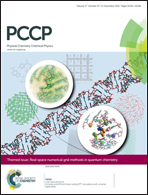How can carbon favor planar multi-coordination in boron-based clusters? Global structures of CBxEy2− (E = Al, Ga, x + y = 4)†
Abstract
With the high preference in forming multi-center bonding, boron has been a miracle ligand in constructing diverse planar multi-coordinate (pM) (tetra/hyper) species. Unfortunately, the boron ligand usually dislikes encompassing a pM carbon (pMC) due to the high competition with pM boron (pMB), which makes the realization of boron-based pMC very difficult and quite challenging. Herein, we propose a strategy that by means of cooperative doping and charge-compensation, we can successfully improve and tune the stability of pMC relative to pMB for CB42−. In the free CBxEy2− (E = Al/Ga) species, ptC is thermodynamically less stable than the global ptB in mono- and di-substituted systems, in agreement with the results of Boldyrev and Wang. However, the thermodynamic preference of pMC increases along with the Al/Ga-doping. The pMC species can be further stabilized by the introduction of the alkaline-earth counterion (Mg2+). CB2E2Mg (E = Al, Ga) designed in the present study represents the first successful design of a boron-based planar penta-coordinate carbon (ppC) structures as the global minima. The strategy proposed in this study should be useful in the manipulation of competition between exotic pMC and pMB in B-based systems.


 Please wait while we load your content...
Please wait while we load your content...